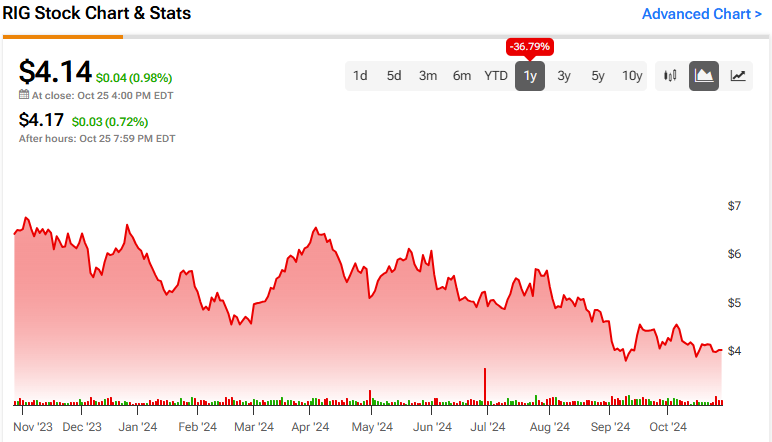As one of the biggest offshore drillers worldwide, Transocean (RIG) is navigating an industry downturn and substantial stock price slump. The company is reportedly discussing a potential merger with Seadrill (SDRL), another player in the offshore drilling scene. This strategic move would solidify Transocean’s growth strategy, increasing its backlog work and expanding its financially flexible and modern fleet optimized for ultra-deepwater drilling. This merger may also position the combined entity on a firmer financial footing, aiding Transocean’s ongoing deleveraging efforts.
Invest with Confidence:
- Follow TipRanks' Top Wall Street Analysts to uncover their success rate and average return.
- Join thousands of data-driven investors – Build your Smart Portfolio for personalized insights.
However, this potential development coincides with weakening global oil demand and a fall in crude futures, hinting at a challenging year ahead for offshore drillers and oilfield services. Despite these headwinds, Transocean remains focused on optimizing its asset portfolio to generate free cash flows and de-leverage its balance sheet, making this a potentially intriguing inflection point for investors interested in exposure to the oil & gas drilling industry.

Transocean’s Potential M&A & Robust Backlog
Transocean is a leading provider of offshore contract drilling services for oil and gas wells worldwide. Its primary operations involve contracting mobile offshore drilling rigs, related equipment, and work crews.
Bloomberg has recently reported that Transocean and Seadrill are exploring the possibility of a merger, with talks focusing on the combined entity’s potential structure. As a standalone entity, Seadrill is the smallest of the four underwater rig companies, and its merger with Transocean would create the industry’s largest offshore operator. Given Transocean’s heavy debt burden, this merger is viewed as a potential deleveraging opportunity for the company, signaling a stronger financial footing for the combined entity.
Transocean’s recent contracts have been boosting the company’s backlog. A one-year contract for the Deepwater Conqueror with an undisclosed operator in the U.S. Gulf of Mexico is expected to bring in approximately $193 million. Further, the company has secured a 365-day contract for the Deepwater Atlas with BP (BP) in the U.S. Gulf of Mexico, bringing a potential of $232 million. Finally, Indian conglomerate Reliance Industries Limited has also awarded a 300-day program to Transocean, set to start in the second quarter of 2026, contributing an estimated $123 million in backlog.
Transocean’s Recent Financial Results
The company reported Q2 financial results in early August. Revenue of $861 million slightly missed analysts’ estimates by $5.41 million. The company saw a net loss of $123 million for the quarter, with operating costs growing as rigs returned to work following contract preparations in Q1 and due to the early retirement of certain employees. Capital expenditures remained nearly steady, with $84 million primarily directed toward the new Deepwater Aquila drillship. The company failed to meet earnings per share expectations, reporting an EPS of -$0.15 compared to the forecast of -$0.11.
CEO Jeremy Thigpen stated that despite missing financial targets, the company had secured several contracts suggesting a tightening market and stressed its ongoing aim to optimize its asset portfolio to maximize EBITDA and generate free cash flows to reduce company debt.
What Is the Price Target for RIG Stock?
The stock has been trending downward, shedding 36% over the past year. It trades at the lower end of its 52-week price range of $3.85 – $8.03, showing ongoing negative price momentum. It trades below the 20-day (4.26) and 50-day (4.48) moving averages. The stock’s P/B ratio of 0.33x appears to be relatively undervalued compared to peers in the Oil & Gas Drilling industry, where the average P/B is 0.82x.
Analysts following the company have taken a cautious stance on RIG stock. For example, Barclays and BofA have reduced their price targets for shares of RIG to $4.50 from $6 and $5.50, respectively, due to anticipated challenges in 2025 expected to arise from a demand shortfall and the number of rigs coming off contract.
Based on ten analysts’ recent recommendations, Transocean is rated a Hold overall. The average price target for RIG stock is $5.86, representing a potential upside of 41.55% from current levels.

Final Thoughts on Transocean
Transocean is pushing through industry challenges, demonstrated by its potential merger talks with Seadrill. This consolidation could strengthen the company’s position, increasing its backlog work and fleet size and aiding in much-needed deleveraging efforts. Despite anticipated global oil demand reductions, the growth strategy suggested by the possible merger or the significant contract backlog offers hope to keep investors’ interest alive. Despite the stock trending downward and the bearish sentiment from analysts, the potential upside of 41.55% from the current price level denotes a silver lining for RIG.









